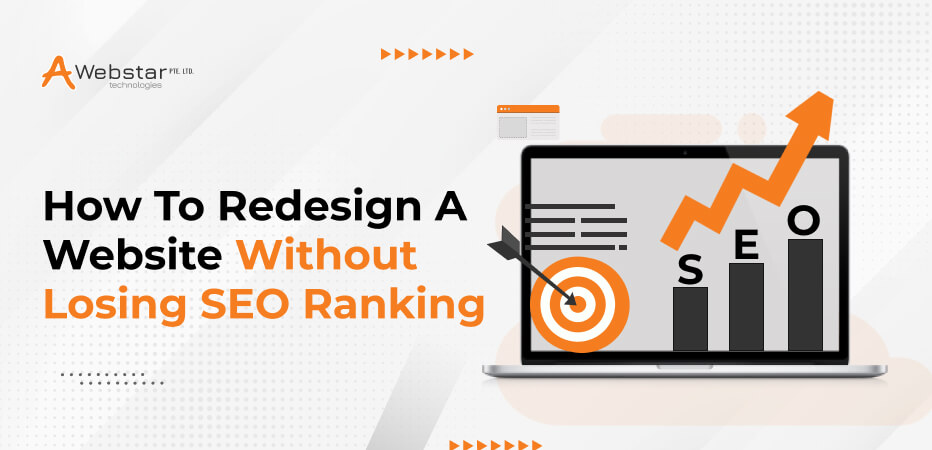
Updating a website is pretty common in the world of the internet. But along with it comes the biggest fear of losing a good hold on search engines. It is natural for people to change their tastes & preferences over time. This could be the reason for some of your rankings dropping.
Hence, it is important to adapt and understand what customers want now, rather than holding on to past successes. Thus, the longer you leave your redesign, the more outdated your site will appear.
Furthermore, new website design methods often lead to better functionality and user experience for your site. Therefore, without any second thoughts, it is possible to redesign a website without losing SEO. Please give it a modern and up-to-date look and make your visitors happier too. Happier visitors will convert into positive leads.
This blog post will walk you through ways to give your website a fresh look. We will make this possible without sacrificing your SEO rankings. So, let us dig deep and learn how to revamp your site while keeping it search engine-friendly.
Here are the Key Steps to Redesigning Your Website Without Losing SEO
Audit Your Current Website
The first and foremost step is to perform a thorough website audit of your old site. The main purpose of this audit is to identify any key elements on your site. These elements are solely responsible for driving traffic, leads and sales for your business.
This will ensure that these valuable pages are not lost in the redesign process. Apart from this, the audit also identifies elements on your site that are not working properly. This may also be a reason for negative user experience. Make sure that these are not carried over from the old site to the new one.
One must look out for various SEO issues including missing meta descriptions, broken internal and external links and duplicate or missing page titles. UberSuggest and Screaming Frog are tools that help you identify these and other SEO issues on your website.
Maintain URL Structure
A minor change can indeed interfere with your website’s SEO. If your present domain name is ranking well, changing it is a huge risk. Your website URL displays your business address on the web. Therefore, search engines must be informed when you change your domain name.
You must visit the Google Search Console to submit a change of address request. Also, it is appropriate to check your website’s search status from the search console itself.
Updating Sitemap.xml and Robots.txt files
After redesigning your site and it has a new structure, the old sitemap becomes ineffective. Therefore, you need to construct a new XML sitemap to submit it to the search engines. It instructs the crawlers on how to proceed with your site indexing.
If you do not want specific pages to be indexed by a search engine you must specify the same in the robots.txt file of your website. The incorrect use of these files can result in your site becoming virtually invisible on the SERPs.
For completely indexing your URL structure ask your SEO expert. Relevant changes must be made to the Txt file and the XML sitemap to achieve optimum results.
Add Redirections
There exist certain pages that do not contribute much to your site’s value. You should redirect these pages to more relevant ones to ensure you get the maximum value from the redesign.
This can be achieved using 301 redirects based on performance criteria and organic ranking. Overall, such redirects make sure that visitors who visit low-value pages are redirected to high-value ones.
Content Optimisation
It is necessary to perform an on-page analysis of your content. For this, try to keep the title, headers, meta descriptions and body of the content of the same length as the previous one. Also, every page must incorporate keywords relevant to your business to reach your SEO targets.
The content optimisation journey begins with appropriate keyword research. Use on-page SEO techniques to boost your page-level rankings. Including the most important keyword in the title tags, meta descriptions, URLs and page content is a great idea.
Responsive Design
It is highly necessary to opt for a responsive design for your website. It must adjust smoothly to various devices and screen sizes.
Responsive design enhances user experience and reduces bounce rates. It further develops a positive impact on SEO rankings. Ultimately, search engines see your site as mobile-friendly and rank it.
Site Speed Optimization
Modern web users expect lightning-fast speeds. Visitors generally expect a page to load in less than two seconds. Also, Google considers page speed a vital ranking factor. Until and unless your site pages are fast enough your Google rankings are destined to take a hit.
Thus, use SEO-friendly tactics such as code minification, caching plugins and content distribution networks to improve your page speed.
Monitoring and Analysing Performance Post-Redesign
It is recommended to gather feedback from users. This must be carried out to understand their experience with the redesigned site. Pay particular attention to user behaviour to achieve optimal results. These include page dwell time, bounce rates and conversion rates. It will help you assess the way website changes are aligning with your audience.
Continuous monitoring and analysis identify SEO issues promptly. It allows you to make necessary adjustments to optimise performance. This way you can ensure that your website maintains its visibility and rankings in search engine results.
Conclusion
The above blog post displays How to redesign a website without losing SEO. You must ensure that your website maintains its search engine visibility and rankings while transforming.
Awebstar Technologies possesses expertise specialising in web design and SEO services. With the support and implementation of best practices, you can confidently redesign your website. It would genuinely meet evolving user needs without even sacrificing hard-earned SEO gains.















































